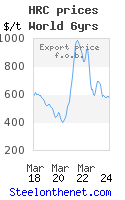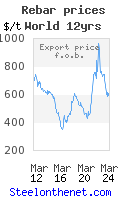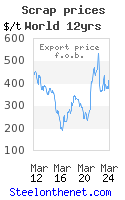Coal Producers Hurt by Lack of Miners [BlackDiamond]
Coal Producers' U.S. Growth Hurt by Lack of Available Miners
Oct. 10 (Bloomberg)
Massey Energy Co. and Arch Coal Inc. can't find enough workers for their mines in Appalachia, the second-biggest U.S. coal-producing region, as they struggle to keep up with rising demand.
The number of coal miners dropped to 99,358 last year from 159,777 in 1990, and more than half are older than 55. Fewer than 100 mine engineers graduated from U.S. schools last year, a fifth of what's needed to replace retirees, according to the U.S. Mine Safety and Health Administration. Mining is the second-most deadly industry, based on U.S. Labor Department data.
"Baby boomers were the last generation to enter the coal mining workforce,'' said Ray McKinney, administrator of the federal mine safety agency in Arlington, Virginia. "We're really concerned about the shortages.''
President George W. Bush is promoting coal to help meet the country's electricity needs over the next decade. Demand for coal is surging as natural-gas prices climb, making it more attractive to run coal-fired power plants. At today's prices, the gas to generate one megawatt-hour of electricity would cost about $133, compared with $27 for coal.
Benchmark gas futures touched a record $14.80 per million British thermal units last month, and the average price this year is more than triple what it was in the 1990s, when most new power plants were gas fired. The price of coal has doubled in about three years, to $58.50 a ton, based on prices at a terminal on the Big Sandy River in West Virginia, the benchmark for Appalachian coal.
Recruiting
Massey, Arch Coal and other mining companies are recruiting using billboards and ads in college magazines. Massey hired an airplane to pull a banner over Myrtle Beach, South Carolina, earlier this year, advertising job openings to high school and college students gathered there for spring break.
"We're trying to find the labor to increase production", Don Blankenship, Massey chairman and chief executive, said at an investor meeting Sept. 26 in New York. "Underground work is different, and sometimes young workers get discouraged."
Massey, the fourth-largest U.S. coal producer, in July said the labor shortage was its biggest impediment to growth. The company is offering free cars and vacations to managers who retain workers. The company also built a medical center in Madison, West Virginia, near many of its mines, as a convenience for workers and a way to control health-care costs.
Massey Shares
Shares of Massey are up 35 percent this year, the smallest gain among the four biggest U.S. coal producers. Massey's coal output was 40.4 million tons last year, down 7.5 percent since 2001, when production peaked. The company lost money from 2001 to 2003 and swung to a profit of $13.9 million last year.
Shares of Peabody Energy Corp., the biggest U.S. coal miner, are up 85 percent this year. Peabody produced 227 million tons of coal last year, up 17 percent from 2001, and had profit of $175.4 million.
Finding and keeping workers ``is something we're paying a lot of attention to,'' Steven Leer, Arch Coal's chief executive, said in a Sept. 14 interview. Shares of Arch Coal, the second-biggest U.S. coal company, have climbed 82 percent this year. The company had profit of $113.7 million last year, up from $16.7 million the year before, as production rose.
Pittsburgh-based Consol Energy Inc., the third-biggest U.S. coal producer, has funded training programs at two-year technical colleges and a new training center at West Virginia University.
Competing with GE
The need for more workers is acute in the Appalachian region and will get worse in other U.S. coal-producing regions over the next 10 years, according to McKinney.
Wyoming's Powder River Basin produces 40 percent of U.S. coal, and the next-biggest regions are Appalachia and Illinois. Richmond, Virginia-based Massey Energy is the biggest coal company in Appalachia and is the biggest employer in the region.
Coal mining is both lucrative and dangerous. Miners' salaries average $50,734 a year, 37 percent higher than the average for all U.S. industries, according to Labor Department data. Mining has the second-highest rate of fatalities, according to the agency. Only the category that includes agriculture, forestry and fishing is more deadly.
According to the mine safety agency's Web site, "nearly every coal miner knows first hand the destructive impact of black lung disease."
"We have to compete with General Electric as much as Arch and Massey," said Tom Hoffman, a spokesman for Consol Energy. "We can't go to a recruiting fair looking like a dinky old coal mining company."
Coal Demand
U.S. coal demand will grow 3.1 percent this year, outpacing a 1.9 percent increase in supplies, according to the Energy Department. The U.S. has enough coal for 250 years.
Coal demand is expected to double in the next 20 years as utilities build more coal-fired power plants. Coal generates more than half of U.S. electricity today.
"Mining is tough, dirty work in sparsely populated areas," said J. Davitt McAteer, a mining professor at Wheeling Jesuit University in West Virginia who was an assistant secretary of labor and head of the Mine Safety and Health Administration during the Clinton administration.
Massey, which loses 60 percent of new hires in their first year, is offering a $25,000 retention bonus to those who stay three years. The company also pays $500 bonuses twice a year.
"Massey's getting desperate and casting a wider net," said Phil Smith, a spokesman for the United Mine Workers of America union in Fairfax, Virginia.
Even regulators are feeling the pinch of too few coal industry workers. "We had two guys we wanted to hire from a mining company, but the company got wind of it and offered them each a $10,000 retention bonus," McKinney said.
Oct. 10 (Bloomberg)
Massey Energy Co. and Arch Coal Inc. can't find enough workers for their mines in Appalachia, the second-biggest U.S. coal-producing region, as they struggle to keep up with rising demand.
The number of coal miners dropped to 99,358 last year from 159,777 in 1990, and more than half are older than 55. Fewer than 100 mine engineers graduated from U.S. schools last year, a fifth of what's needed to replace retirees, according to the U.S. Mine Safety and Health Administration. Mining is the second-most deadly industry, based on U.S. Labor Department data.
"Baby boomers were the last generation to enter the coal mining workforce,'' said Ray McKinney, administrator of the federal mine safety agency in Arlington, Virginia. "We're really concerned about the shortages.''
President George W. Bush is promoting coal to help meet the country's electricity needs over the next decade. Demand for coal is surging as natural-gas prices climb, making it more attractive to run coal-fired power plants. At today's prices, the gas to generate one megawatt-hour of electricity would cost about $133, compared with $27 for coal.
Benchmark gas futures touched a record $14.80 per million British thermal units last month, and the average price this year is more than triple what it was in the 1990s, when most new power plants were gas fired. The price of coal has doubled in about three years, to $58.50 a ton, based on prices at a terminal on the Big Sandy River in West Virginia, the benchmark for Appalachian coal.
Recruiting
Massey, Arch Coal and other mining companies are recruiting using billboards and ads in college magazines. Massey hired an airplane to pull a banner over Myrtle Beach, South Carolina, earlier this year, advertising job openings to high school and college students gathered there for spring break.
"We're trying to find the labor to increase production", Don Blankenship, Massey chairman and chief executive, said at an investor meeting Sept. 26 in New York. "Underground work is different, and sometimes young workers get discouraged."
Massey, the fourth-largest U.S. coal producer, in July said the labor shortage was its biggest impediment to growth. The company is offering free cars and vacations to managers who retain workers. The company also built a medical center in Madison, West Virginia, near many of its mines, as a convenience for workers and a way to control health-care costs.
Massey Shares
Shares of Massey are up 35 percent this year, the smallest gain among the four biggest U.S. coal producers. Massey's coal output was 40.4 million tons last year, down 7.5 percent since 2001, when production peaked. The company lost money from 2001 to 2003 and swung to a profit of $13.9 million last year.
Shares of Peabody Energy Corp., the biggest U.S. coal miner, are up 85 percent this year. Peabody produced 227 million tons of coal last year, up 17 percent from 2001, and had profit of $175.4 million.
Finding and keeping workers ``is something we're paying a lot of attention to,'' Steven Leer, Arch Coal's chief executive, said in a Sept. 14 interview. Shares of Arch Coal, the second-biggest U.S. coal company, have climbed 82 percent this year. The company had profit of $113.7 million last year, up from $16.7 million the year before, as production rose.
Pittsburgh-based Consol Energy Inc., the third-biggest U.S. coal producer, has funded training programs at two-year technical colleges and a new training center at West Virginia University.
Competing with GE
The need for more workers is acute in the Appalachian region and will get worse in other U.S. coal-producing regions over the next 10 years, according to McKinney.
Wyoming's Powder River Basin produces 40 percent of U.S. coal, and the next-biggest regions are Appalachia and Illinois. Richmond, Virginia-based Massey Energy is the biggest coal company in Appalachia and is the biggest employer in the region.
Coal mining is both lucrative and dangerous. Miners' salaries average $50,734 a year, 37 percent higher than the average for all U.S. industries, according to Labor Department data. Mining has the second-highest rate of fatalities, according to the agency. Only the category that includes agriculture, forestry and fishing is more deadly.
According to the mine safety agency's Web site, "nearly every coal miner knows first hand the destructive impact of black lung disease."
"We have to compete with General Electric as much as Arch and Massey," said Tom Hoffman, a spokesman for Consol Energy. "We can't go to a recruiting fair looking like a dinky old coal mining company."
Coal Demand
U.S. coal demand will grow 3.1 percent this year, outpacing a 1.9 percent increase in supplies, according to the Energy Department. The U.S. has enough coal for 250 years.
Coal demand is expected to double in the next 20 years as utilities build more coal-fired power plants. Coal generates more than half of U.S. electricity today.
"Mining is tough, dirty work in sparsely populated areas," said J. Davitt McAteer, a mining professor at Wheeling Jesuit University in West Virginia who was an assistant secretary of labor and head of the Mine Safety and Health Administration during the Clinton administration.
Massey, which loses 60 percent of new hires in their first year, is offering a $25,000 retention bonus to those who stay three years. The company also pays $500 bonuses twice a year.
"Massey's getting desperate and casting a wider net," said Phil Smith, a spokesman for the United Mine Workers of America union in Fairfax, Virginia.
Even regulators are feeling the pinch of too few coal industry workers. "We had two guys we wanted to hire from a mining company, but the company got wind of it and offered them each a $10,000 retention bonus," McKinney said.




0 Comments:
Post a Comment
<< Home